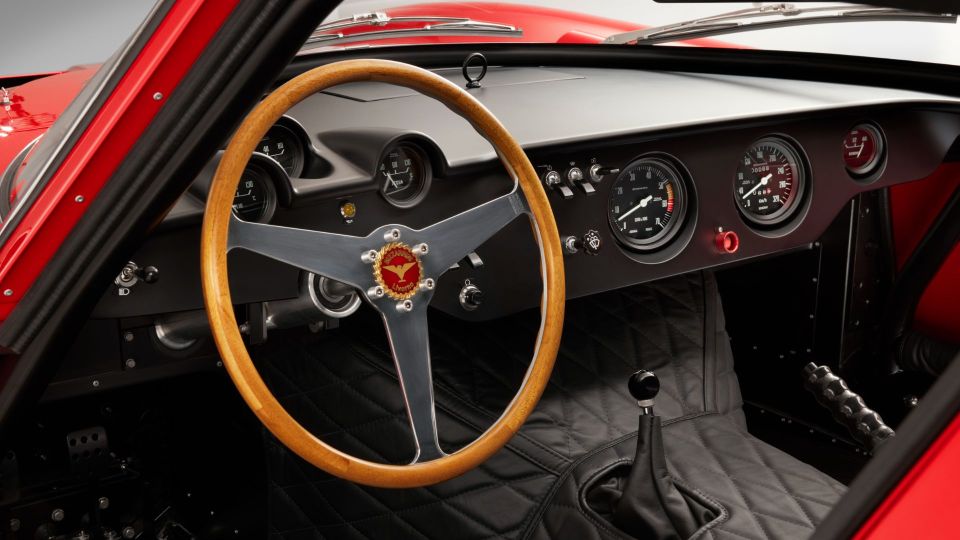Bizzarrini 5300 GT Corsa Revival review: driving a Le Mans legend

Giotto Bizzarrini and Ferruccio Lamborghini both fell out with Enzo Ferrari, then exacted revenge by building their own sports cars. Yet while Lamborghini became a revered household name, Bizzarrini has largely been forgotten. Until now, perhaps.
His fame may have been fleeting, but Bizzarrini – still alive today, at 96 years old – is a true titan of the Italian car industry. After studying the new-fangled science of aerodynamics at Pisa university, he was promoted to chief engineer at Ferrari, where he oversaw the Testa Rossa, 250 GT SWB and peerless 250 GTO.
Bizzarrini parted ways with Ferrari after the infamous ‘palace coup’ of 1961, when five senior staff complained about the influence of Enzo’s wife and were promptly sacked. His parting shot, of sorts, was to design a V12 engine for rival Lamborghini, which served from the original 350 GT until the Murcielago SV of 2010.
A Le Mans legend

Still, Giotto wanted to go it alone. After founding the short-lived ATS marque, he developed the Iso Grifo into the Bizzarrini 5300 GT. The racing ‘Corsa’ version won its class at Le Mans in 1965, beating the Ford GT40s to finish ninth overall and cementing Bizzarrini’s name into history. Sadly, just four years later, the company was declared bankrupt.
Now Bizzarrini is back – initially with a tribute to that against-the-odds Le Mans victory, then with a modern hypercar. More on the latter shortly. The 5300 GT Corsa Revival is an exacting recreation of car 222, the 1965 winner, which now resides in the Petersen Museum in Los Angeles.
The main difference is its carbon fibre body, although you can specify period-correct fibreglass if you want to compete in historic motorsport. Just 24 cars will be made, priced at £1.65 million each.
All-American muscle

The 5300 GT’s flat sides and chopped ‘Kamm’ tail – both designed with aerodynamics in mind – set it apart from other sports racers. It isn’t as beautiful as a 250 GTO, but it oozes 1960s glamour. Details faithfully copied from car 222 include the yellow ‘prototipo’ roundels, single wing mirror and tiny lamps to illuminate each race number.
Fold yourself through the FIA-spec rollcage and you discover an outstretched driving position and very ‘classic’ ergonomics. The oil pressure gauge is dead ahead, while the speedo and rev counter are in front of your passenger. The gear lever for the four-speed manual ’box is inscribed with Roman numerals – another quirky touch from car 222.
The Ferraris it tussled with had highly-strung V12s, but Bizzarrini used a brawny 5.3-litre Chevrolet V8. Inhaling through four Weber carburettors, it develops 400hp, or 480hp in full race spec. Prime the fuel pump and it wallops boisterously into life. It has the easygoing gait of a muscle car at low revs, then soars towards the 6,500rpm limiter with an ear-splitting snarl.
A physical education

Driving the 5300 GT is physical and full-on. Its unassisted steering and unservoed brakes both demand firm inputs, while its all-independent suspension thumps over every ripple in the road. Like any racing car, it prefers to go hard and fast – not least because its Dunlop cross-ply tyres proffer very little grip until they get warm.
As your confidence builds, though, the chassis’ fine balance shines through. Its V8 is mounted so far back the 5300 GT is technically mid-engined, and that translates into keen turn-in and a hilarious ability to drift through corners. When Bizzarrini test driver Tommy Erdos – a Le Mans winner himself – swaps seats to take me for a few hot laps, the car seems to constantly rotate around its axis.
If you want the authentic 1960s Le Mans experience, without the risk of damaging a near-priceless original, the 5300 GT is an adrenalin-hit like little else. The reborn Bizzarrini’s next move is a 1,000hp naturally aspirated V12 hypercar, due to be revealed later this year. Once again, Ferrari and Lamborghini may have cause to worry.
Tim Pitt writes for Motoring Research
PRICE: £1.65 million
POWER: 410hp
0-62MPH: 4.2sec
TOP SPEED: 190mph
FUEL ECONOMY: 20mpg (est.)
KERB WEIGHT: 1,230kg